The idea of making my own foie gras came to me when I went to a party and the hostess had made her own. It was just the way I like it – mouth-melting. So when Relationnel came home from work one day and said that the Comité d’entreprise* had a special offer for a foie gras cooking class with l’Atelier des Chefs we jumped at the chance! I got off the plane from a exhausting week teaching technical translation in Chennai in India, dropped my luggage and headed over to the Atelier, a little groggy with jet lag.
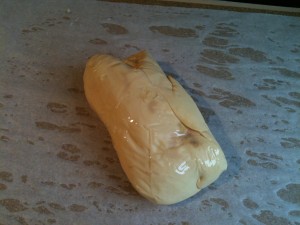 They told us not to take notes, that we’d be given full instructions to go home with us. That was a mistake – it’s taken us about 5 years to fill in the gaps and get it right so this post is definitely a scoop! It was all very fun and interesting though and we got to taste the chef’s foie gras at the end and take home our own creations which lived up to expectations. I’m going to try and describe the process, but I’m not convinced you can really do it without having some sort of demonstration. So I suggest you watch this video by L’Atelier des Chefs even though it’s in French. The second part shows how to cover the foie gras with chocolate, but that’s not in my recipe!
They told us not to take notes, that we’d be given full instructions to go home with us. That was a mistake – it’s taken us about 5 years to fill in the gaps and get it right so this post is definitely a scoop! It was all very fun and interesting though and we got to taste the chef’s foie gras at the end and take home our own creations which lived up to expectations. I’m going to try and describe the process, but I’m not convinced you can really do it without having some sort of demonstration. So I suggest you watch this video by L’Atelier des Chefs even though it’s in French. The second part shows how to cover the foie gras with chocolate, but that’s not in my recipe!
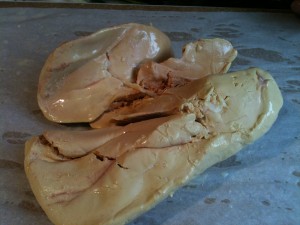 The result mainly depends on the quality of the foie gras itself. A couple of years ago, we bought some Eastern European foie gras on the market – much cheaper – but were very disappointed with the results. Now we ask for “high quality foie gras” from the south west of France at the butcher’s on Rue Montorgueil. It usually weighs 500 to 700 grams. The one I bought this time was 500 grams and cost 30 euros. The same foie gras (mi-cuit) bought from the traiteur costs 110 to 120 euros a kilo, so making your own is definitely more economical.
The result mainly depends on the quality of the foie gras itself. A couple of years ago, we bought some Eastern European foie gras on the market – much cheaper – but were very disappointed with the results. Now we ask for “high quality foie gras” from the south west of France at the butcher’s on Rue Montorgueil. It usually weighs 500 to 700 grams. The one I bought this time was 500 grams and cost 30 euros. The same foie gras (mi-cuit) bought from the traiteur costs 110 to 120 euros a kilo, so making your own is definitely more economical.
It needs to be cooked at least 5 days before you eat it and you need one or two days to make it. The first thing you do is to soak the whole foie gras in a mixture of ½ litre of milk and 10 grams of coarse salt with enough water to cover. You leave it in the fridge overnight or at ambient temperature for 1 ½ hours if you’re pushed for time. Cover the top of the foie gras with greaseproof paper to stop it drying out and take it out about an hour before you use it.
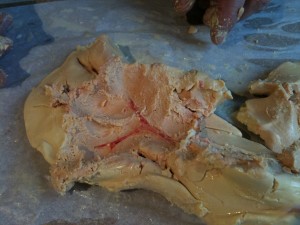 Next day, you get everything ready beforehand because once you’ve got your hands in the foie gras, it’s like having them in butter, only worse. The seasoning is important and very precise : 8 grams per 500 grams of foie gras, consisting of 7 grams of fine salt, ½ gram of freshly-ground pepper and ½ gram of 5-spice mixture (cinnamom, cloves, star anis, fennel and brown peppercorns). Since few people have scales with that type of precision, it’s a good idea to make up a bigger batch and keep it in a screw-top jar. Measure out the 8 grams and put it into a small cup with a coffee spoon.
Next day, you get everything ready beforehand because once you’ve got your hands in the foie gras, it’s like having them in butter, only worse. The seasoning is important and very precise : 8 grams per 500 grams of foie gras, consisting of 7 grams of fine salt, ½ gram of freshly-ground pepper and ½ gram of 5-spice mixture (cinnamom, cloves, star anis, fennel and brown peppercorns). Since few people have scales with that type of precision, it’s a good idea to make up a bigger batch and keep it in a screw-top jar. Measure out the 8 grams and put it into a small cup with a coffee spoon.
Another thing is keeping your hands and the foie gras cold enough. Relationnel (who likes very sophisticated cooking equipment) has a very handy marble plaque that is perfect. You just put it in the fridge for a couple of hours beforehand (this means taking everything off one shelf of course …) or on the balcony if it’s cold enough. You then moisten it slightly and cover with a sheet of greaseproof paper or cling-film (if you feel brave enough) as it makes the foie gras easier to handle and faciltates cleaning up afterwards. Of course, any other flat surface works as well!
You then measure out the white port wine (3 deciliters) into a small cup and add a coffee spoon. Put some iced water into a bowl to dip your fingers in when the foie gras gets too slippery. You can also turn off the heating in the kitchen which I invariably forget to do. Put the terrine (or a small aluminium tray) on the table next to you together with a few pieces of paper towel (to clean your iPhone when you drop it on top of the foie gras you’re trying to photograph) and a sharp pointed knife. Now you’re ready to go!
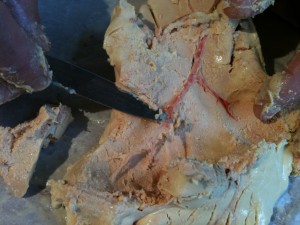 Place the foie gras on the greaseproof paper. Gently separate the two lobes. One is much bigger than the other. Gently open up the big lobe lengthways, sort of running your finger along it. You’ll see a large Y-shaped vein which you have to remove without breaking it. Now the idea is to knead the foie gras underneath to release the vein, lifting the vein very gently with a knife but not cutting it. The foie gras gets completely mashed in the process but that’s normal. After you remove the first vein, you’ll find a second, larger one, underneath. Repeat the process. The second lobe also has two veins, but they are star-shaped this time.
Place the foie gras on the greaseproof paper. Gently separate the two lobes. One is much bigger than the other. Gently open up the big lobe lengthways, sort of running your finger along it. You’ll see a large Y-shaped vein which you have to remove without breaking it. Now the idea is to knead the foie gras underneath to release the vein, lifting the vein very gently with a knife but not cutting it. The foie gras gets completely mashed in the process but that’s normal. After you remove the first vein, you’ll find a second, larger one, underneath. Repeat the process. The second lobe also has two veins, but they are star-shaped this time.
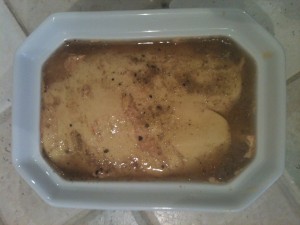 Once the veins have been removed, gather up all the bits and pieces of foie gras and put them back on the lobes. Sprinkle about half the seasoning evenly over the two lobes, then dissolve with about half the port wine. Put the two lobes together like a sandwich then put into the terrine or aluminium tray after sprinkling some more of the seasoning on the bottom. The terrine should be just big enough to take the foie gras. Push down on the top to remove any air, then sprinkle with the rest of the seasoning and port wine. It always seems like a lot to me but it really is just the right amount.
Once the veins have been removed, gather up all the bits and pieces of foie gras and put them back on the lobes. Sprinkle about half the seasoning evenly over the two lobes, then dissolve with about half the port wine. Put the two lobes together like a sandwich then put into the terrine or aluminium tray after sprinkling some more of the seasoning on the bottom. The terrine should be just big enough to take the foie gras. Push down on the top to remove any air, then sprinkle with the rest of the seasoning and port wine. It always seems like a lot to me but it really is just the right amount.
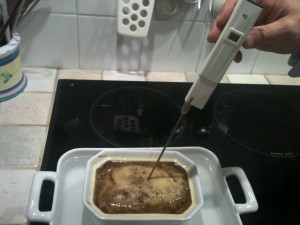 Now is what I consider to be the most delicate part – the cooking. The important thing is getting the core at just the right temperature (the sides are always hotter). You place the terrine or aluminium tray in a larger tray and fill with water and cook for 20 to 25 minutes at 150°C. You can use a thermometer to check when it gets to 37°C (body temperature) but also a skewer, which is less precise of course because you have to judge the temperature yourself. After taking it out the oven you place a press on top (you can make this with a thick piece of cardboard covered in alfoil) and leave at ambient temperature for about 30 minutes. The fat will congeal on top and preserve the foie gras. We then wrap it all in cling wrap to keep it airtight.
Now is what I consider to be the most delicate part – the cooking. The important thing is getting the core at just the right temperature (the sides are always hotter). You place the terrine or aluminium tray in a larger tray and fill with water and cook for 20 to 25 minutes at 150°C. You can use a thermometer to check when it gets to 37°C (body temperature) but also a skewer, which is less precise of course because you have to judge the temperature yourself. After taking it out the oven you place a press on top (you can make this with a thick piece of cardboard covered in alfoil) and leave at ambient temperature for about 30 minutes. The fat will congeal on top and preserve the foie gras. We then wrap it all in cling wrap to keep it airtight.
Enjoy!
Recipe: One 500 g lobe of foie gras 7 g salt 1/2 g of freshly ground pepper 1/2 g of five spices 3 centiliters of white port wine Cooking time: 150°C for 20 to 25 minutes.*Companies with over 50 employees in France have to set up a « works committee » with staff representatives and pay a subsidy at least equal to 0.2% of the wages bill. Depending on the size of the company, employees can then benefit from various lurks and perks such as reductions on holiday accommodation, wine-tasting courses and cooking classes!
L’Atelier des Chefs: http://www.atelierdeschefs.fr/





Again, very interesting! I love foie gras. We always buy a stock of it when we go to St. Jean de Luz on vacation. I also prefer mi-cuit. I’ve never been tempted to make my own because I’m afraid it would turn me off of eating it. I get a bit funny about food if I prepare it myself. It’s silly because I love cooking and baking. Anything meat-related is a real challenge for me though. I get grossed out easily by the texture and smell of raw meat and poultry. The more I have to stick my hands in it, the harder it is to eat. The kids love meatballs. I try to use a spoon but it’s just not as good as using your hands (ew!)
That said, I’m sure I’ll end up trying to make my own some day because I like experimenting new things and I like a challenge 🙂
Certainly a disadvantage! I fortunately do not have any qualms about meat. Not that keen on preparing fish though, but am getting used to it. You could get your little boy onto making the meatballs. He’d love it.
I loooove foie gras too and over the years have collected lots of recipes, but moving first to the mountains in Bella Italia then back to Kiwiland has kind of put paid to any dreams of that although I am tempted whenever I travel to Froggieland by car. Your recipe looks simple and delicious, but I have a strong aversion to Chinese five spice. Not sure why because I like the spices separately. Have you translated five spice from “quatre épices”? If so, I replace quatre épices with allspice when I’m outside France, plus possibly a pince of cinnamon and nutmeg, with only the tiniest skerick of cloves if you want.
Actually I have two recipes from the same people: one says 4 épices and the other 5 épices! Allspice is just one spice of course. You could no doubt use the Australian mixed spice. All you really need are the spices listed in the post.
Although allspice is just one spice, it is very complex and is a good equivalent for the quatre épices in my opinion. I don’t like five spice so I would have to replace with something else (allspice or NZ mixed spice probably, although mixed spice is a little stronger, tangier and cinnamony). I was just curious because swapping between FR, IT and EN recipes I’ve come up against the mixed spice, five spice, quatre épices problem often.
Le Mesturet is posting their foie gras recipe tomorrow in answer to my question about 4 and 5 spices. Will keep you posted. You might like to join their FB fan page – http://www.facebook.com/lemesturet
Wow. Will look forward to it!!
Here it is but there’s no 4 or 5 spice mix! http://www.lemesturet.com/page/l-almanach-du-mesturet/recettes-du-chef/recette-du-restaurant-le-mesturet—le-foie-gras-847.html
Interesting. Similar to yours minus the spices. I expect that even the choice of alcohol will influence the flavour. I’ve seen all sorts of additions and different wines or spirits used, but I don’t have them to hand to check.
I guess it’s a matter of taste. If I’m not mistaken, Chinese five spice is quite often associated with duck in Chinese recipes so it’s probably a good combination – if you like it!
Ah yes, the choice of alcohol makes a big difference. But “4 épices” is a traditional French mixture of cinnamon, cloves, nutmeg and ginger which existed long before the Chinese 5 spices. I don’t think their instructions are very clear though. I prefer the recipe from the Atelier des Chefs that we use.
I love foie gras but I think I would be too scared to do it myself! Kudos to you!! I’m going to see if I can master pate before I try it! 🙂
You know, I think it’s probably easier to make foie gras, just a little bit messier! Why don’t you ask France? I’d love to know her reaction.
Great post, thank you! I dream of being able to cook this next time I am in France. Will definitely try to hire an apartment instead of a hotel, so I can cook this wonderful delicacy. Just found your blog and am loving it!
Welcome Lori! Renting an apartment is definitely the way to try cooking foie gras. You need to allow 7 to 10 days to eat it though …